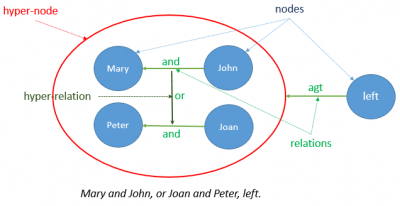Hyper-node
From UNL Wiki
(Difference between revisions)
| Line 5: | Line 5: | ||
== Basic Concepts == | == Basic Concepts == | ||
| − | {{: | + | {{:Grammar units}} |
== Elements == | == Elements == | ||
Revision as of 19:43, 19 August 2013
Hyper-nodes are nodes containing relations between nodes. They represent scopes or sub-graphs.
Contents |
Basic Symbols
| Symbol | Definition | Example |
|---|---|---|
| ( ) | node | (%a) |
| " " | string | "went" |
| [ ] | natural language entry (headword) | [go] |
| [[ ]] | UW | [[to go(icl>to move)]] |
| // | regular expression | /a{2,3}/ = aa,aaa |
| rel(x;y) | relation | agt(kill;Peter) |
| ^ | not | ^a = not a |
| { | } | or | {a|b} = a or b |
| % | index for nodes, attributes and values | %x |
| : | scope ID | :01 |
| # | index for sub-NLWs | #01 |
| = | attribute-value assignment | POS=NOU |
| ! | rule trigger | !PLR |
| & | merge operator | %x&%y |
| ? | dictionary lookup operator | ?[a] |
Basic Concepts
- Node
- A node is the most elementary unit in the graph. It is the result of the tokenization process, and corresponds to the notion of "lexical item". At the surface level, a natural language sentence is considered a list of nodes, and a UNL graph a set of relations between nodes.
- Relation
- In order to form a natural language sentence or a UNL graph, nodes are inter-related by relations. In the UNL framework, there are three different types of relations: the linear (list) relation, syntactic relations and semantic relations.
- Hyper-Node
- A hyper-node is a sub-graph, i.e., a scope: a node containing relations between nodes.
- Hyper-Relation
- A hyper-relation is a relation between relations.
Elements
As any node, hyper-nodes are vectors (uni-dimensional) arrays containing the following necessary elements:
- a string, represented between "quotes"
- a headword, represented between [simple square brackets]
- a UW, represented between [[double square brackets]]
- features, of which the internal relations are a special type
- an index, preceded by %
Examples
Examples of hyper-nodes are the following:
- (("a")("b")) - a hyper-node containing a linear relation between the nodes ("a") and ("b")
- (VC(%x;%y)VA(%x;%z)) - a hyper-node containing two syntactic relations: VC(%x;%y) AND VA(%x;%z)
- (agt([a];[b])obj([a];[c])) - a hyper-node containing two semantic relations: agt([a];[b]) AND obj([a];[c])
- (([kick],V)([the],D)([bucket],N),V,NTST) - a hyper-node having the features N and NTST and containing two linear relations: one between the nodes ([kick],V) and ([the],D), and other between ([the],D) and [bucket],N)
- (([kick],V)([the],D)([bucket],N),"kick the bucket",[[die]],V,NTST) - the same as before, except for the fact that the hyper-node has string = "kick the bucket" and UW = [[die]]
Hyper-nodes may also contain internal hyper-nodes:
- ((("a")("b"))("c")) - a hyper-node containing a linear relation between the hyper-node (("a")("b")) and the node ("c")
Properties of hyper-nodes
- As any node, hyper-nodes are expressed between (parentheses)
- (("a")("b"))
- As any node, hyper-nodes may have one single string, one single headword and one single UW, but may have as many features and internal relations as necessary
- (([kick],V)([the],D)([bucket],N),"kick the bucket",[kick the bucket],[[die]],V,NTST)
- As any node, hyper-nodes may be referenced by any of its elements, including internal relations
- (([kick],V)) - refers to any hyper-node containing the node ([kick],V)
- (([the],D)([bucket],N)) - refers to any hyper-node containing a linear relation between ([the],D) AND ([bucket],N)
- (([kick],D),([bucket],N)) - refers to any hyper-node containing the nodes ([kick],V) AND ([bucket],N)
- When a hyper-node is deleted, all its internal relations are deleted as well
- (([kick],V)([the],D)([bucket],N)):=; (the hyper-node is deleted, as well as the relations ([kick],V)([the],D) AND ([the],D)([bucket],N))
